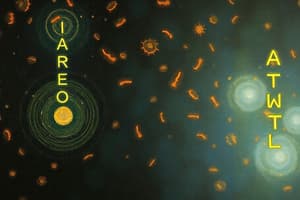Podcast
Questions and Answers
What is the primary source of energy for cells in the human body?
What is the primary source of energy for cells in the human body?
- Proteins
- Lipids
- Mitochondria (correct)
- Carbohydrates
What is the primary role of digestive enzymes?
What is the primary role of digestive enzymes?
- Synthesizing complex food molecules
- Breaking down complex food molecules into smaller fragments (correct)
- Transporting nutrients across cell membranes
- Storing energy in the form of ATP
Which of the following is NOT a function of the cardiovascular system in relation to cellular energy production?
Which of the following is NOT a function of the cardiovascular system in relation to cellular energy production?
- Removing waste products from cells
- Distributing nutrients to cells
- Generating energy from nutrients (correct)
- Transporting oxygen to cells
What is the term used to describe the breakdown of organic molecules to release energy?
What is the term used to describe the breakdown of organic molecules to release energy?
Which of the following statements is TRUE regarding the energy requirements of different tissues?
Which of the following statements is TRUE regarding the energy requirements of different tissues?
Which of the following is NOT a building block of complex food molecules?
Which of the following is NOT a building block of complex food molecules?
Where does the majority of the first steps in catabolism occur?
Where does the majority of the first steps in catabolism occur?
What is the primary function of ATP in cellular metabolism?
What is the primary function of ATP in cellular metabolism?
What is the primary role of mitochondria in cellular metabolism?
What is the primary role of mitochondria in cellular metabolism?
Which of the following statements accurately describes the relationship between catabolism and anabolism?
Which of the following statements accurately describes the relationship between catabolism and anabolism?
Which of the following is NOT a primary reason why cells synthesize new organic components?
Which of the following is NOT a primary reason why cells synthesize new organic components?
What is the primary source of organic molecules for both catabolism and anabolism?
What is the primary source of organic molecules for both catabolism and anabolism?
Which of the following is a TRUE statement regarding mitochondrial activity?
Which of the following is a TRUE statement regarding mitochondrial activity?
What percentage of energy released during catabolism is typically captured and used to generate ATP by mitochondria?
What percentage of energy released during catabolism is typically captured and used to generate ATP by mitochondria?
What is the primary function of ATP produced by mitochondria?
What is the primary function of ATP produced by mitochondria?
Which of the following is an example of a cellular activity that requires ATP?
Which of the following is an example of a cellular activity that requires ATP?
What is the primary reason cells store nutrient reserves?
What is the primary reason cells store nutrient reserves?
Which of the following statements about cellular metabolism is TRUE?
Which of the following statements about cellular metabolism is TRUE?
Flashcards
Cells as chemical factories
Cells as chemical factories
Cells break down organic molecules to obtain energy.
ATP
ATP
Adenosine triphosphate, the body's main energy carrier.
Mitochondria
Mitochondria
Organelles that provide most cellular energy through chemical reactions.
Oxygen absorption
Oxygen absorption
Signup and view all the flashcards
Nutrient absorption
Nutrient absorption
Signup and view all the flashcards
Metabolism
Metabolism
Signup and view all the flashcards
Catabolism
Catabolism
Signup and view all the flashcards
Energetics
Energetics
Signup and view all the flashcards
Triglycerides
Triglycerides
Signup and view all the flashcards
Nutrient Pool
Nutrient Pool
Signup and view all the flashcards
Citric Acid Cycle
Citric Acid Cycle
Signup and view all the flashcards
Electron Transport System
Electron Transport System
Signup and view all the flashcards
Metabolic Turnover
Metabolic Turnover
Signup and view all the flashcards
Amino Acids
Amino Acids
Signup and view all the flashcards
Study Notes
Cellular Energy Production
- Cells are chemical factories, breaking down organic molecules to produce energy for ATP, the body's main high-energy compound.
- Mitochondria are the primary energy producers in cells.
- Cellular energy production involves oxygen and nutrient intake.
- Lungs absorb oxygen.
- Digestive tract absorbs nutrients (water, vitamins, minerals, carbohydrates, lipids, and proteins).
- The cardiovascular system distributes these to cells.
- Tissue-specific energy needs vary due to cell type diversity.
- Metabolic needs fluctuate based on activity levels (rest/exercise), time of day (awake/sleep), and age (child/adult).
- Energetics is the study of energy flow and its conversions.
Metabolism Overview
- Metabolism encompasses all chemical reactions in the body.
- Cellular metabolism involves the cell's chemical reactions, sustaining homeostasis and essential functions.
- Organic compounds (amino acids, lipids, simple sugars) cross the plasma membrane and contribute to the cytosol's nutrient pool.
- Catabolism is the breakdown of organic molecules, releasing energy to synthesize ATP or other high-energy compounds.
- Catabolism occurs in steps.
- Early steps (cytosol) break down large organic molecules into smaller fragments (carbohydrates to short chains, triglycerides to fatty acids and glycerol, proteins to amino acids).
- Later steps (mitochondria) further break down molecules, generating significant energy capture (approximately 40%).
- The energy captured converts ADP to ATP. The remaining energy is released as heat.
- Anabolism is the synthesis of new organic molecules that involves the formation of new chemical bonds.
- ATP from mitochondria fuels anabolism and other cell processes.
Nutrient Processing and Energy Production
-
Cells obtain organic molecules from the interstitial fluid.
-
Catabolism, however, only produces about 40% usable energy in the form of ATP.
-
Different cells require varying amounts of ATP based on their specific functions (contraction in muscle cells, secretion in glands).
-
Cells synthesize organic materials for several reasons:
- Maintenance and repair (replenishing cell components).
- Growth (increased size and protein/organelle synthesis).
- Secretion (creating and transporting substances).
- Nutrient storage (preparing for low external supply)
-
Nutrients are categorized by preference order for energy.
-
Mitochondria are selective in the organic molecules they use.
-
Cytosol prepares molecules for mitochondrial processing.
-
Mitochondria break down molecules into carbon dioxide, water, and ATP via pathways such as the citric acid cycle and electron transport system.
-
ATP is fundamental to all essential cell processes.
Studying That Suits You
Use AI to generate personalized quizzes and flashcards to suit your learning preferences.




